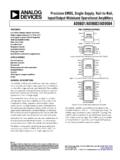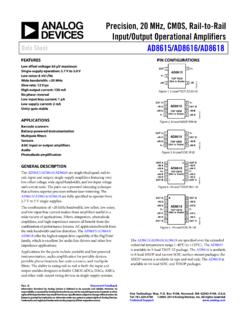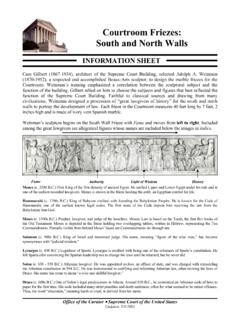Transcription of 2.2 Sewage Sludge Incineration - US EPA
1 1/95 Solid Waste Sewage Sludge IncinerationThere are approximately 170 Sewage Sludge Incineration (SSI) plants in operation in the UnitedStates. Three main types of incinerators are used: multiple hearth, fluidized bed, and electric infrared. Some Sludge is co-fired with municipal solid waste in combustors based on refuse combustion technology(see Section ). Refuse co-fired with Sludge in combustors based on Sludge incinerating technology islimited to multiple hearth incinerators 80 percent of the identified operating Sludge incinerators are of the multiple hearth design. About 15 percent are fluidized bed combustors and 3 percent are electric.
2 The remaining combustorsco-fire refuse with Sludge . Most Sludge incinerators are located in the Eastern United States, though thereare a significant number on the West Coast. New York has the largest number of facilities with 33. Pennsylvania and Michigan have the next-largest numbers of facilities with 21 and 19 sites, Sludge incinerator emissions are currently regulated under 40 CFR Part 60, Subpart O and40 CFR Part 61, Subparts C and E. Subpart O in Part 60 establishes a New Source Performance Standardfor particulate matter. Subparts C and E of Part 61--National Emission Standards for Hazardous AirPollutants (NESHAP)--establish emission limits for beryllium and mercury, 1989, technical standards for the use and disposal of Sewage Sludge were proposed as 40 CFRPart 503, under authority of Section 405 of the Clean Water Act.
3 Subpart G of this proposed Part 503proposes to establish national emission limits for arsenic, beryllium, cadmium, chromium, lead, mercury,nickel, and total hydrocarbons from Sewage Sludge incinerators. The proposed limits for mercury andberyllium are based on the assumptions used in developing the NESHAPs for these pollutants, and noadditional controls were proposed to be required. Carbon monoxide emissions were examined, but nolimit was Process Description1,2 Types of Incineration described in this section include:- Multiple hearth,- Fluidized bed, and- hearth cyclone, rotary kiln, and wet air oxidation are also briefly Multiple Hearth Furnaces -The multiple hearth furnace was originally developed for mineral ore roasting nearly a centuryago.
4 The air-cooled variation has been used to incinerate Sewage Sludge since the 1930s. A cross-sectional diagram of a typical multiple hearth furnace is shown in Figure The basic multiple hearthfurnace (MHF) is a vertically oriented cylinder. The outer shell is constructed of steel, lined withrefractory, and surrounds a series of horizontal refractory hearths. A hollow cast iron rotating shaft runsthrough the center of the hearths. Cooling air is introduced into the shaft which FACTORS1/95 Figure Cross Section of a Multiple Hearth Furnace1/95 Solid Waste the hearths. Each rabble arm is equipped with a number of teeth, approximately 6 inches in length,and spaced about 10 inches apart.
5 The teeth are shaped to rake the Sludge in a spiral motion, alternating indirection from the outside in, to the inside out, between hearths. Typically, the upper and lower hearthsare fitted with four rabble arms, and the middle hearths are fitted with two. Burners, providing auxiliaryheat, are located in the sidewalls of the most multiple hearth furnaces, partially dewatered Sludge is fed onto the perimeter of the tophearth. The rabble arms move the Sludge through the incinerator by raking the Sludge toward the centershaft where it drops through holes located at the center of the hearth. In the next hearth the Sludge is rakedin the opposite direction.
6 This process is repeated in all of the subsequent hearths. The effect of the rabblemotion is to break up solid material to allow better surface contact with heat and oxygen. A Sludge depthof about 1 inch is maintained in each hearth at the design Sludge flow may also be fed to one or more hearths of the incinerator. Scum is the material that floats onwastewater. It is generally composed of vegetable and mineral oils, grease, hair, waxes, fats, and othermaterials that will float. Scum may be removed from many treatment units including preaeration tanks,skimming tanks, and sedimentation tanks. Quantities of scum are generally small compared to those ofother wastewater air is first ducted through the central shaft and its associated rabble arms.
7 A portion, orall, of this air is then taken from the top of the shaft and recirculated into the lowermost hearth aspreheated combustion air. Shaft cooling air which is not circulated back into the furnace is ducted into thestack downstream of the air pollution control devices. The combustion air flows upward through the dropholes in the hearths, countercurrent to the flow of the Sludge , before being exhausted from the top hearth. Air enters the bottom to cool the ash. Provisions are usually made to inject ambient air directly into themiddle hearths as the standpoint of the overall Incineration process, multiple hearth furnaces can be dividedinto three zones.
8 The upper hearths comprise the drying zone where most of the moisture in the Sludge isevaporated. The temperature in the drying zone is typically between 425 and 760EC (800 and 1400EF). Sludge combustion occurs in the middle hearths (second zone) as the temperature is increased to about925EC (1700EF). The combustion zone can be further subdivided into the upper-middle hearths where thevolatile gases and solids are burned, and the lower-middle hearths where most of the fixed carbon iscombusted. The third zone, made up of the lowermost hearth(s), is the cooling zone. In this zone the ashis cooled as its heat is transferred to the incoming combustion hearth furnaces are sometimes operated with afterburners to further reduce odors andconcentrations of unburned hydrocarbons.
9 In afterburning, furnace exhaust gases are ducted to a chamberwhere they are mixed with supplemental fuel and air and completely combusted. Some incinerators havethe flexibility to allow Sludge to be fed to a lower hearth, thus allowing the upper hearth(s) to functionessentially as an normal operating condition, 50 to 100 percent excess air must be added to an MHF in orderto ensure complete combustion of the Sludge . Besides enhancing contact between fuel and oxygen in thefurnace, these relatively high rates of excess air are necessary to compensate for normal variations in boththe organic characteristics of the Sludge feed and the rate at which it enters the incinerator.
10 When aninadequate amount of excess air is available, only partial oxidation of the carbon will occur, with aresultant increase in emissions of carbon monoxide, soot, and hydrocarbons. Too much excess air, on the other hand, can cause increased entrainment of particulate and unnecessarilyhigh auxiliary fuel hearth furnace emissions are usually controlled by a venturi scrubber, an FACTORS1/95tray scrubber, or a combination of both. Wet cyclones and dry cyclones are also used. Wet electrostaticprecipitators (Wet ESPs) are being installed as retrofits where tighter limits on particulate matter andmetals are required by State Fluidized Bed Incinerators -Fluidized bed technology was first developed by the petroleum industry to be used for catalystregeneration.














